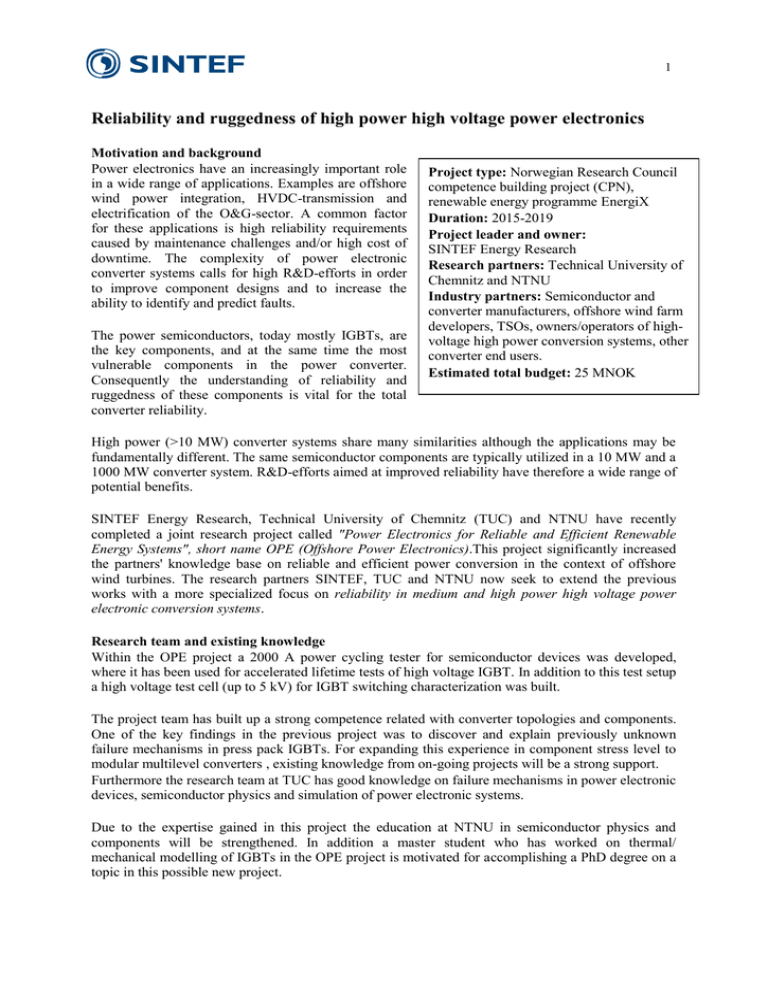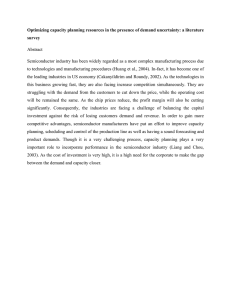Reliability and ruggedness of high power high voltage
advertisement

1 Reliability and ruggedness of high power high voltage power electronics Motivation and background Power electronics have an increasingly important role in a wide range of applications. Examples are offshore wind power integration, HVDC-transmission and electrification of the O&G-sector. A common factor for these applications is high reliability requirements caused by maintenance challenges and/or high cost of downtime. The complexity of power electronic converter systems calls for high R&D-efforts in order to improve component designs and to increase the ability to identify and predict faults. The power semiconductors, today mostly IGBTs, are the key components, and at the same time the most vulnerable components in the power converter. Consequently the understanding of reliability and ruggedness of these components is vital for the total converter reliability. Project type: Norwegian Research Council competence building project (CPN), renewable energy programme EnergiX Duration: 2015-2019 Project leader and owner: SINTEF Energy Research Research partners: Technical University of Chemnitz and NTNU Industry partners: Semiconductor and converter manufacturers, offshore wind farm developers, TSOs, owners/operators of highvoltage high power conversion systems, other converter end users. Estimated total budget: 25 MNOK High power (>10 MW) converter systems share many similarities although the applications may be fundamentally different. The same semiconductor components are typically utilized in a 10 MW and a 1000 MW converter system. R&D-efforts aimed at improved reliability have therefore a wide range of potential benefits. SINTEF Energy Research, Technical University of Chemnitz (TUC) and NTNU have recently completed a joint research project called "Power Electronics for Reliable and Efficient Renewable Energy Systems", short name OPE (Offshore Power Electronics).This project significantly increased the partners' knowledge base on reliable and efficient power conversion in the context of offshore wind turbines. The research partners SINTEF, TUC and NTNU now seek to extend the previous works with a more specialized focus on reliability in medium and high power high voltage power electronic conversion systems. Research team and existing knowledge Within the OPE project a 2000 A power cycling tester for semiconductor devices was developed, where it has been used for accelerated lifetime tests of high voltage IGBT. In addition to this test setup a high voltage test cell (up to 5 kV) for IGBT switching characterization was built. The project team has built up a strong competence related with converter topologies and components. One of the key findings in the previous project was to discover and explain previously unknown failure mechanisms in press pack IGBTs. For expanding this experience in component stress level to modular multilevel converters , existing knowledge from on-going projects will be a strong support. Furthermore the research team at TUC has good knowledge on failure mechanisms in power electronic devices, semiconductor physics and simulation of power electronic systems. Due to the expertise gained in this project the education at NTNU in semiconductor physics and components will be strengthened. In addition a master student who has worked on thermal/ mechanical modelling of IGBTs in the OPE project is motivated for accomplishing a PhD degree on a topic in this possible new project. 2 Project description Work package 1: Providing reference converter topologies and semiconductor components for case studies The objective of this WP is to provide a set of relevant converter topologies and semiconductor components. Further, to evaluate and compare thermal stress and efficiency for these topologies. Develop case studies used in other WPs for comparison. Case specification should include converter topology (two-level, multi-level etc.) and a reference state-of-the-art semiconductor. Development of fast and accurate transient simulation models (e.g. PSCAD) based on the methodology in the OPE-project. Coupling of electric circuit simulation, control circuits, loss calculation and thermal network simulation. The WP will provide important decision basis for the other WPs. Work package 2: Evaluation of different accelerate lifetime tests for power electronic devices The objective of this WP is to contribute towards standardization of semiconductor lifetime tests. Develop accelerated lifetime test scheme close to application (high voltage / high power) Recent publications offer a wide spread of methodologies to conduct accelerate lifetime tests. Hence a comparison of the results is hardly possible. Therefore the existing methodologies should be compared building the basis for a standardized lifetime test. This test should provide testing close to the intended application. Work package 3: Ruggedness of IGBTs The objective of this WP is to contribute towards development of robust components aiming to reduce downtime of HV converters. Primary focus is aimed at obtaining a stable behavior during and after fault conditions. It is of increasing importance to develop highly robust devices who can withstand repetitive overload. In addition the behavior of the devices during fault conditions should be investigated. For example for series connected IGBTs it is of vital importance for the continuing operation that a failure in a single device results in short circuit for that device. The WP will include a PhD-scholarship at the Technical University of Chemnitz Work package 4: Accelerated lifetime testing and reliability of recent IGBT devices The objective of this WP is the development of a lifetime model for state of the art IGBT devices, based on experience from existing models. The project will focus on recent development in HV high power components with main focus on IGBTs. Experience and resources from the OPE projects will be exploited for establishing such models. This also includes simulations as well as experimental work for validations and verifications of the proposed models. Work package 5: Real-time condition monitoring and prediction of remaining lifetime The objective of this WP is to develop a methodology to online estimate remaining lifetime of a semiconductor. Second, the methodology should be able to detect abnormal operation conditions and give early warning of failures. During the OPE-project good knowledge on lifetime curves, failure modes and how to monitor a power electronic system was gained. With this knowledge combined with expertize from TUC a methodology will be developed to estimate the thermal stress on different components online. Subsequent the load dependent stress is accumulated and an online estimation of the remaining lifetime of the different components will be calculated. Furthermore the focus will be set to cost efficient solutions like i.e. thermal impedance spectroscopy. 3 Work package 6: Contribution to education The objective of this WP is to strengthen the education of applied power electronics at NTNU on topics related to reliability of power semiconductors Due to a fast development and ongoing research it is hard to keep the teaching up to date. Therefore a course of study will be developed addressing the reliability of power electronics, failure mechanisms, lifetime models and packaging technologies. For this work package a PostDoc at NTNU is suggested. The special courses will be developed and offered to master students as well as for continuing education for engineers in the industry. In addition to the project team at SINTEF Energy Research and NTNU, important contributors to such courses will be the experts at TU Chemnitz, as well as invited contributors from the component industry. High voltage IGBT planar modules and press-pack disks – Devises under power cycling and image from thermal-mechanical simulations


